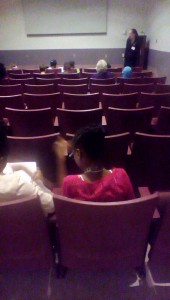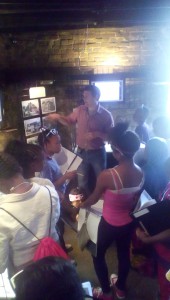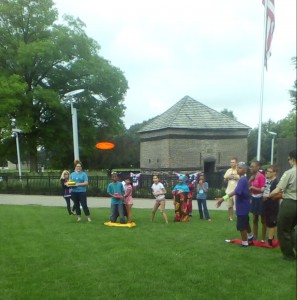By Russell Finelsen, 10th Grade, Bethel Park High School
On July 10, despite overcast skies, Pittsburgh Public School students involved in the Summer Dreamers program trekked to the Fort Pitt Museum as a part of the Pittsburgh’s History Detectives Program to learn about Pittsburgh’s history, including prominent figures and historical forts.
The program started five years ago, but it has gone through some changes since its launch. “This is the program’s fifth summer,” program organizer Nathan Rodda said. “About three summers ago, we decided to start a part of the program to help children learn about history and become student historians of the city,” he added.
“The Fort Pitt Museum and the [Heinz] History Center are connected, and we wanted to have students to have the full experience. We now have students coming to the Fort Pitt Museum to learn about history,” Rodda said.
Throughout the program, students “analyze [historical] objects and do activities about figures involved in the history of Pittsburgh, like William Pitt,” Rodda explained
Why is William Pitt so important? Tour leader Kathleen McLean explained to the students that the city was named after Pitt, and he helped create the city.
The tour started in the theater. Each student received a binder with worksheets, and each sheet was completed after the related activity. The first activity of the day was watching a movie about the city of Pittsburgh before the French and Indian War. The video discussed the Indian tribes in the area, like the Monongahela and Iroquois, and their favorable trading relationships with the British. The movie also described how the British and the French fought over the Ohio River valley in small wars, like King George’s War, due to their respective need for land during that time. After the movie concluded, students completed the first worksheet, which concluded in asking them if Pittsburgh land belonged to the Indians, British, or French. Even though McLean did not give away the answer, I felt that the movie was very informative and told the story from all the perspectives.

Students in the Pittsburgh’s History Detectives converse about if Pittsburgh was British, French, or Native American land before the French and Indian War.
After the movie, students were shown a picture on the floor that was the seal of William Pitt. Through the seal, students learned how Pitt impacted the city of Pittsburgh. “William Pitt took land and made it into what we now know is Pittsburgh,” McLean said. The students then examined the seal, and compared it to the city of Pittsburgh. “The seal has black and gold, which are the colors of the Steelers, and blue and white, which were the old colors of the Penguins,” McLean said. Students then listed similarities and differences between the Pitt seal and the city of Pittsburgh seal. This helped the students fully realize the impact Pitt made on the city back in the 18th century and now in the 20th and 21st centuries.
Students on the tour then moved a few steps forward to view a diorama of Point State Park and Fort Pitt in the 18th century. McLean described Fort Pitt, including its bastions, or points, and the locations of gunpowder. She also told students about old forts that were destroyed by the French. These forts included Fort Duquesne, Fort Mercer, and Fort Prince George. However, students quickly noticed a rubber ducky in the diorama. McLean explained that the museum put the rubber ducky in the diorama to help students remember the diorama and other exhibits in the museum. This also helped the students remember specific details about the diorama that they may have forgotten if the rubber ducky had not been there.
The students then left the museum and traveled to the Fort Pitt Block House, where they met James, a museum employee. “The building is dark and is the oldest in Pittsburgh,” James said. “It is 261 years old, and it is the last building from the old Fort Pitt.” James explained that when Fort Pitt was not needed, the building was torn down, and its parts were used for other forts and housing. However, he said that Isaac Craig, a businessman and politician who lived in Pittsburgh, bought the building in the 1810s to use as his own home. The block house was then moved from owner to owner until it was bought by the Daughters of the American Revolution, who remodeled it and opened it to the public.
James then explained the ins-and-outs of the block house. He showed students the fire step, and explained that soldiers used it to see the enemy and shoot their muskets. The soldiers then stepped down to reload and protect themselves from returning gunfire. James went on to say that the second floor of the block house was also used for soldiers. He explained that the second floor did not have a firing step as soldiers could just step up to the space for shooting, and could kneel down to escape returning gunfire. Students then transferred this information into their binders and answered worksheet questions about the block house.

James points to the steps in the back of the Fort Pitt Block House and explains why the stairs and the second floor was put in.
The final stop of the day was the green space just outside the museum. The students met Jess, a ranger in Point State Park. She explained that remnants of Fort Pitt were used for housing in present day Pittsburgh. In addition, she talked about how Point State Park was created. She explained, “Residents wanted a park in Pittsburgh. Residents then bought land, tore down the abandoned warehouses and railroads, and made it into what is now Point State Park.”
The students ended the day with a fun, yet challenging, game of Frisbee golf, in which students eliminated their opponents by scoring.

A student in the program scores in a elimination Frisbee golf game to knock his opponent out of the game.
The day of touring was part of a bigger project. “Students use iPads to create video projects about what they learned about the history of Pittsburgh,” Rodda said. He explained that on the iPads, students create iMovies about what they have seen and learned, and then present the projects at the end of the program.
Rodda also said that some other changes may be in order to the program. “The Summer Dreamers program is looking to open itself to students outside the Pittsburgh Public Schools District,” Rodda said. “We also want to focus on different subjects like science and technology.”
However, Rodda also said there are many reasons to join the program for next year. He said “We use interactive materials to display our progress. In addition, students get to learn what life was like in Pittsburgh [in the 18th century].”
For more photos of Pittsburgh’s History Detectives, click here.
Russell Finelsen is a rising sophomore at Bethel Park High School. He is the editor-in-chief of the school’s newspaper, Hawk Eye, where he has written over 150 articles and is a member of the Quill and Scroll Society for Student Journalists. His hobbies include reading, travelling, and watching sports.
1 Comment
Becoming History Detectives | Heinz History Center Blog
[…] by reading these three articles by student reporters from Pittsburgh Youth Media that covered it: Summer Dreamers Become Pittsburgh’s History Detectives, Summer Dreamers Turn History Detectives, and History Detectives Discover Local Pittsburgh […]
Leave a Comment